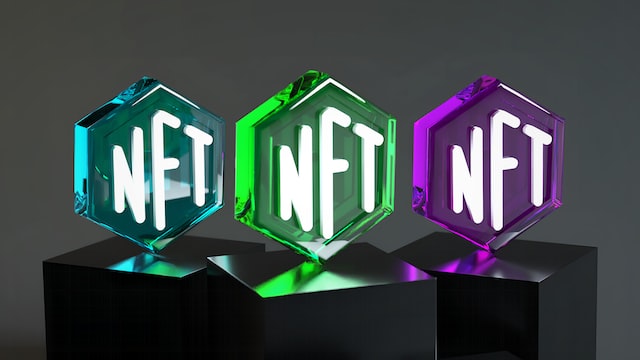Non-fungible tokens, or NFTs, are unique digital assets that are verified on a blockchain. They differ from other digital assets like cryptocurrencies because they cannot be exchanged for other assets of equal value. Instead, each NFT has its unique value and can represent a wide range of digital and physical items, including art, music, videos, and even virtual real estate.
One of the key benefits of NFTs is that they provide a way to prove ownership and authenticity of digital items. With traditional digital assets, it is often difficult to determine who owns a particular item and whether it is an original or a copy. NFTs solve this problem by using blockchain technology to create a permanent and unchangeable record of ownership. This can be especially valuable for artists, musicians, and other creators who want to ensure that their work is properly credited and compensated.
NFTs are created using smart contracts on a blockchain platform, such as Ethereum. A smart contract is a self-executing contract with the terms of the agreement between buyer and seller being directly written into lines of code. The code and the agreements contained therein are stored and replicated on the Ethereum blockchain.
To create an NFT, an artist or creator will first design their digital asset using a program like Adobe Photoshop or Blender. They will then use a tool like OpenSea or Mintable to create a smart contract on the Ethereum blockchain and specify the details of the NFT, such as its name, description, and price. The NFT is then minted, or added to the blockchain, and a unique digital token is created and assigned to the NFT. This token serves as proof of ownership and can be bought and sold like any other asset.
There are several different types of NFTs, depending on the type of item they represent. Some common types of NFTs include:
- Art NFTs: These are digital artworks, such as paintings or drawings, that have been turned into NFTs. They can be displayed on a digital canvas or even printed out and hung on a wall like traditional artwork.
- Music NFTs: These are digital audio files, such as songs or album tracks, that have been turned into NFTs. They can be played on a digital music platform or downloaded and played on a device like a smartphone or MP3 player.
- Video NFTs: These are digital video files, such as movies or TV shows, that have been turned into NFTs. They can be streamed on a digital video platform or downloaded and played on a device like a television or a computer.
- Virtual real estate NFTs: These are digital properties, such as plots of land or entire virtual worlds, that have been turned into NFTs. They can be used to represent ownership of virtual space in games or other online environments.
One of the main reasons that NFTs have gained so much popularity in recent years is the potential for them to revolutionize the way that digital assets are bought and sold. In the past, it has been difficult for artists and creators to profit from their digital works because it was easy for others to copy and distribute them without permission. NFTs offer a way for artists to sell their digital creations directly to collectors and fans, ensuring that they are properly compensated for their work.
Another reason that NFTs have gained traction is the growing interest in cryptocurrency and blockchain technology. Many people are attracted to the idea of owning a unique digital asset that is verified on the blockchain, and they see NFTs as a way to get involved in this emerging market.
However, NFTs are not without controversy. Some critics argue that the hype around NFTs is unsustainable and that the market is oversaturated with low-quality works. There have also been concerns about the environmental impact of the Ethereum blockchain, which is used to create and verify many NFTs. The energy consumption of the blockchain has been a point of controversy, as the process of “mining” new blocks requires a significant amount of electricity.
Despite these criticisms, NFTs show no signs of slowing down. The market for NFTs has exploded in recent years, with record-breaking sales and mainstream adoption by artists, musicians, and even sports teams. In March 2021, a digital artwork by the artist Beeple sold for a record-breaking $69 million at a Christie’s auction, cementing the mainstream appeal of NFTs.
It remains to be seen how the market for NFTs will evolve in the future, but it is clear that they have the potential to change the way we think about digital ownership and authenticity. As more and more people become interested in buying and selling unique digital assets, NFTs will likely continue to gain in popularity and mainstream adoption.
Notice: Information contained herein is not and should not be construed as an offer, solicitation, or recommendation to buy or sell securities. The information has been obtained from sources we believe to be reliable; however, no guarantee is made or implied with respect to its accuracy, timeliness, or completeness. Authors may own the cryptocurrency they discuss. The information and content are subject to change without notice. Visionary Financial and its affiliates do not provide investment, tax, legal, or accounting advice.
This material has been prepared for informational purposes only and is the opinion of the author, and is not intended to provide, and should not be relied on for, investment, tax, legal, accounting advice. You should consult your own investment, tax, legal, and accounting advisors before engaging in any transaction. All content published by Visionary Financial is not an endorsement whatsoever. Visionary Financial was not compensated to submit this article. Please also visit our Privacy policy; disclaimer; and terms and conditions page for further information.

